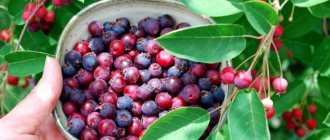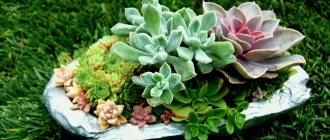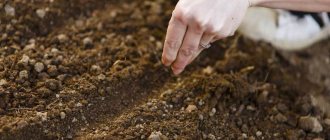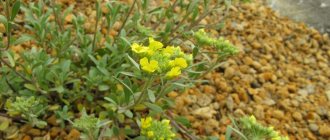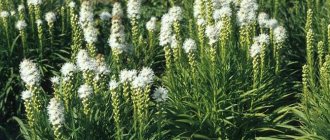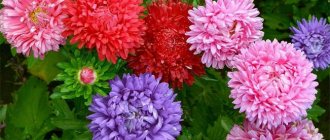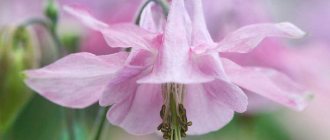In pursuit of various exotic trees or shrubs, which are not only capricious, but also require increased attention, our gardeners often overlook some unpretentious plants. But many of them are no less decorative and useful. Among them, the pretty shrub serviceberry stands out. The plant also has a number of beneficial properties. In folk medicine, not only berries, but also the bark and leaves of this deciduous shrub are widely used.
Planting a shadberry plant and caring for it is quite simple. And the culture itself is so interesting and unusual that it is simply surprising how it could end up on the outskirts of domestic garden plots. This article provides detailed information about the shadberry plant - photos, medicinal properties, cultivation features. Another name for the crop is currant. From the Mongolian language the meaning of the word irgai is translated as “very hard wood”.
general information
The shadberry plant, the photo of which is presented below, is found in almost the entire Northern Hemisphere. It grows in North Africa and America, and in the countries of the Far East, as well as in the Caucasus and Crimea. It can often be seen in forest clearings, as well as in the mountains among thickets of other bushes. Irga is a plant that thrives in any soil. The only place where it grows is swampy land where there is standing water. The main condition for normal fruit ripening is a sufficient amount of light. In such conditions, the fruits become large, juicy and healthy. This feature is inherent in all cultivated varieties of plants of the rose family, which includes serviceberry. Under normal agrotechnical conditions, the plant produces on average about fifteen kilograms of berries from each bush over the entire period of fruit ripening. In addition, they are incredibly healthy and are widely used in cooking.
What does the plant look like?
Irga looks especially attractive in early spring. When the first flowers appear on its branches, the bush is completely covered with very delicate fibers. They completely cover the plant. Irga, whose photos are incredibly beautiful this season, gains a unique charm in early spring. She appears to be wearing a white or pinkish shawl. When the inflorescences begin to fall off, the villi also gradually disappear. The description of the serviceberry plant depends on the type of crop. In our country, the round-leaved species is more common - it comes from the Caucasus and Crimea. In addition to it, spicate, Canadian, and blood-red varieties are also cultivated.
From the name you can already understand how these types differ from each other. What all representatives of this plant have in common is their erect young shoots, colored brown-red. Their growth continues until mid-July. The length of the annual growth ranges from 60 to 100 cm. The leaves of the serviceberry, located on long petioles, can be round, ovoid or oval, depending on the species. They have jagged edges. The leaves sometimes reach 10 cm in length. If you look at the photo of what the shadberry plant looks like in spring, summer and autumn, you can see that a change in color occurs. The leaves are brownish-green when they bloom, in June they become bluish-green, but after picking the berries they acquire golden-purple hues.
Planting and care
Irga is the same shrub that is not difficult to plant and care for. From the “set it and forget it” series. Planting is usually done in early spring or autumn. Like many shrubs, serviceberry loves well-lit places. Although some varieties do well in shaded areas. The optimal and convenient place for planting is along the fence. Regarding the soil, it is unpretentious.
For planting, two-year-old seedlings . Usually 1-2 bushes are planted per plot. From a larger number of seedlings, you can build a luxurious hedge. And then the birds will settle on your site. When planting a hedge in a checkerboard pattern, the optimal distance between bushes is 1-1.5 m, between rows – 2-3 meters.
When planting, it is advisable to add fertilizers:
- humus - 2 buckets per hole;
- superphosphate – 300 g;
- potassium sulfate – 200 gr.
After planting the seedlings, be sure to water (10 liters of water per hole). Then, the top layer of soil must be mulched with humus or peat. The aerial part should be shortened to 10 cm, leaving a few healthy buds. Irga is very responsive to fertilizers, especially organic ones. Therefore, it is recommended to feed with urea in the second year in the summer (1 tbsp per 10 liters of water).
In the fall, it is advisable to loosen the soil and add the following to each bush:
- wood ash - 2/3 liter jar;
- superphosphate – 200 g;
- potassium sulfate – 1 tbsp.
For more mature shrubs, you need to add 1-2 buckets of humus from the compost pit. Undoubtedly, with such feeding, irga will delight you with a rich harvest, and the berries will be large, tasty and beautiful.
Irgu should be pruned regularly in spring. As a rule, only a few new shoots are left. After a few years, 10-12 main shoots remain, which only need to be cleared of broken and diseased branches.

Also, with the help of pruning, it is important to keep the bush at a height of 2-2.5 meters, not allowing it to grow upward. Otherwise, harvesting will be very inconvenient. And it is possible that more berries will go to the birds.
An important advantage of serviceberry is frost resistance. Some varieties can easily tolerate sudden weather changes and low temperatures. Therefore, you don’t need to cover the shadberry for the winter.
Varieties
The pretty green plant serviceberry has about 25 species. Some of them are distinguished by special beauty. Let's look at the most common of them. For example, the Canadian serviceberry plant, also known as wineberry, found in northern gardens, can grow up to seven meters. Its oblong branches create a wide, dense oval crown. The leaves are ovoid in shape. During the blooming period they are brownish, in summer they are bluish, and in autumn they are golden or reddish. The leaf blade is soft to the touch, slightly rough and with a delicate fluff. The Canadian shadberry plant blooms in late spring: its large white buds are collected in graceful clusters. The fruits of this shrub are similar to rose hips.
Another large deciduous plant, Lamarck's serviceberry, is widely used in cooking. It grows up to 5 m and is distinguished by oval-shaped leaves with a jagged frame. The inflorescences of this variety are small and white. They appear on the bush in huge quantities, so this plant looks very beautiful in the spring and summer.
Irga, photos, medicinal properties and cultivation features of which are presented below, blooms for about ten days. Healing berries appear only on mature bushes that are at least four years old.
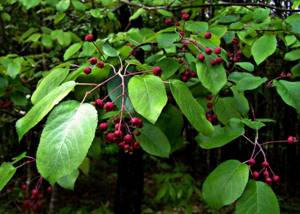
Another variety, the common serviceberry, grows only up to three meters. A culture can grow in one place for more than fifteen years. Another garden shrub, Corinca rotundifolia, reaches a height of four meters. It has slightly drooping shoots, colored bright brown.
The berries on the bushes of this variety are first green, then scarlet, and when fully ripe they are dark blue, almost black.
Popular varieties of serviceberry
At this time, only one variety is represented in the state register of the Russian Federation. In total, there are about 30 varieties of serviceberry. Each of them is special, with its own care requirements.
Irga Starry Night
This variety of serviceberry was bred by Russian breeders through pollination of alder serviceberry. Compact trees rarely grow more than three meters. Fruiting begins at 5 years of age
.
The harvest from a young tree is from 4 to 5 kg. A fully mature harvest can be harvested in early July.
Irga alnifolia Starry Night - photo of berries on a bush
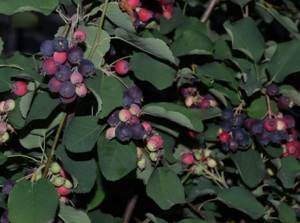
. From 10 to 15 berries are formed on one brush.
Starry Night is one of the most delicious varieties of serviceberry
. The fruits are good both fresh and processed. Taste rating on a 5-point scale – 4.8. Withstands drought and frost well. Has high immunity.

Serviceberry variety Mandan
A selection variety of serviceberry obtained from a Canadian species. A low compact bush no higher than two meters. Its decorative crown is presented in the shape of a candle.
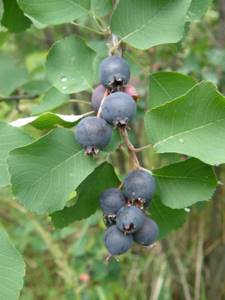
Having reached the age of three to four years, the Magadan variety of serviceberry begins to bear fruit with large and very sweet berries. In one brush there are from 10 to 12 berries weighing 1.5 grams. The surprisingly juicy pulp makes it resistant to lack of moisture.
The best gooseberry varieties for the Moscow region
This variety of serviceberry is frost-resistant and can withstand frosts down to -40 degrees below 0
. Has good immunity. The fruiting period is from 30 years and longer.
Irga variety Slate
A well-known variety of Canadian serviceberry, which gardeners most often use as a decorative planting, and not for harvesting. Mature plants are up to 2 meters in height with a luxurious dense crown.
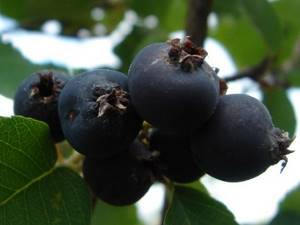
This shadberry ripens early and bears fruit with black juicy berries
.
Slate belongs to varieties of sweet serviceberry with excellent taste characteristics and a refreshing fruity aroma. This is a winter-hardy variety of serviceberry, although it prefers warmth
.
Irga Smokey
The variety of Canadian origin is represented by a tall bush. Irga Smokey is considered the most common in Canada and the USA, grown on an industrial scale
. At first it grows vertically, after which it begins to grow in width, gaining volume. Begins to bear fruit at the age of three to four years.
A high-yielding variety of serviceberry: up to 7.5 kg is collected from one planted tree. The first fruits appear at the end of July.

The color of the peel is almost black, and the aroma is very rich, almost black. There is a waxy coating on the peel. The fruits are spherical in shape with a large number of seeds inside. The variety is good for consumption in any form.
Blueberry varieties for the Moscow region - the most delicious
Smoky requires crown thinning and timely harvesting. It is necessary to water frequently, avoiding dryness. This is one of the best frost-resistant varieties of serviceberry.
. And yet, he has excellent immunity.
Irga Forestburg
The Canadian serviceberry variety is represented by vigorous, spreading bushes. It begins bearing fruit at the age of three to four years. The fruits are ready for harvest at the end of July. They are very large, up to 16 mm in diameter, spherical in shape.
Photo of serviceberry variety Forestburg

There is a slight waxy coating on the dark blue skin. The advantage of this Canadian variety of serviceberry is its constant yield, as well as decorativeness and high immunity. The Forestburg variety hardly gets sick and pleases with its beautiful, elegant appearance for a long time.
Irga variety Krasnoyarsk
Serviceberry variety from Russian breeders for Siberia
.
An adult plant reaches 3.5 meters in height and gives a good harvest of up to 10 kg per tree. This is a late-ripening variety of serviceberry
; it fully ripens in July. The berries have a rich purple color skin and very fragrant sweet pulp with slight sourness. Taste characteristics depend on the ripeness of the fruit.
Irga alnifolia Krasnoyarsk - photo

The weight of one is from 1 to 4 g. Although this variety of serviceberry is intended for Siberia, it loves warm and sunlit areas. The bush forms a crown on its own, which greatly simplifies care. Resistant to 40-degree frosts
.
Irga Martin
Canadian high-yielding large-fruited variety of serviceberry, which has become widespread in North America. Fruiting begins in the third or fourth year after planting. The berries ripen in June, which is why Martin is an early serviceberry variety.
. The fruits are large, up to 18 mm in diameter, spherical in shape. The skin is dark blue.
All the berries ripen almost at the same time, which is very convenient when harvesting. The Martin serviceberry variety is large-fruited, the berries are about 16-18 mm in diameter. You don't have to rush to pick the fruits because they don't fall off. The variety is not susceptible to pests and diseases. In particular, it is resistant to powdery mildew. This is one of the best varieties of serviceberry for the Moscow region
.
Irga Pearson
The mid-season variety of Canadian selection of serviceberry is represented by tall bushes with many trunks. It begins to bear fruit at the age of three to four years. The fruits are ready for harvest in late July.
The berries of this serviceberry are medium and large, up to 18 mm in diameter. The color is dark blue with a waxy coating. The taste of irgi Pearson is amazing, as is the aroma
.
There is juicy pulp inside. All the fruits ripen together. The variety is not afraid of low sub-zero temperatures; the winter hardiness of serviceberry Pearson is very high
.
Serviceberry variety Nelson
This plant has an interesting history. It was discovered in 1974 and named after its discoverer. The maximum height is 4.5 meters. The berries are medium in size - 1.2-1.3 cm. The taste of the Nelson serviceberry is tart, with a slight sourness
.
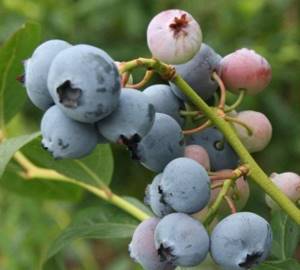
The fruits are spherical and large. As they ripen, they darken and at the final stage of maturity acquire a blue-black color. There are small amounts of seeds inside. Irga Nelson is resistant to juniper rust.
The disadvantage is that the fruits do not ripen at the same time, and therefore you have to harvest in several stages.
Irga canadiana Northline
An alder-leaved variety of serviceberry of Canadian selection. Mature bushes reach a height of 4 meters, and fruit formation occurs in the third year of life. About 10 kg are collected from one planting
. The fruit has an unusual shape for serviceberry - in the shape of a pear.

. All the berries ripen at the same time. The variety is undemanding in terms of soil composition and is easy to care for, in particular, watering.
On a note!
The winter hardiness of the Northline variety of shadberry is quite high - down to -25 degrees and even lower, which makes it quite suitable for growing in the Moscow region.
Irga Pembina
A relatively low perennial from breeders from Canada. Ornamental bushes can grow up to 3.5 meters in height.
The fruits are dense, fleshy, up to 18 mm in diameter. They have a sugary taste, not for everyone. The color of fully ripe berries is blue-black.

Pembina is a winter-hardy variety of serviceberry that can withstand temperatures down to -50 degrees below zero.
. This variety of serviceberry can be grown in the Urals, Siberia and other more severe areas.
Irga Altaglow
This is a super decorative variety of serviceberry that looks simply excellent throughout the year.
. It is grown both for decorative purposes and for harvest. Mature bushes are very tall - from 6 to 8 meters in height.
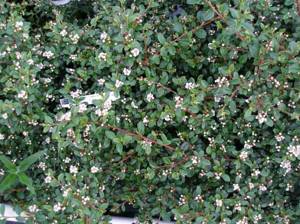
The pyramidal crown visually stretches the planting. This variety can be immediately recognized by the creamy white color of the berries. This is not the only advantage of the tall variety of serviceberry Altaglow. The fruits are tasty and aromatic.
Irga Thiessen
The Canadian variety belongs to the alder species. The bush grows up to 5 meters in height and has a dense crown in the shape of a ball. It begins bearing fruit at the age of three to four years. The color of the berries is blue-black. Ripening begins in late July.
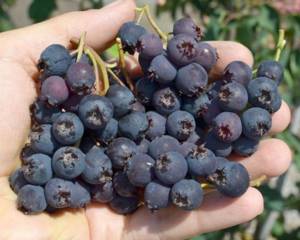
But the variety has excellent immunity and is very durable. Life expectancy is up to 70 years
.
Irga JB30
The tall shrub of serviceberry JB30 grows up to 6 meters
. Despite this growth, it has a very compact crown. Productivity up to 20 kg from planting. The size of the fruit is up to 17 mm in diameter.
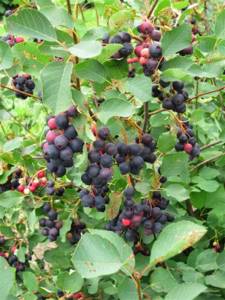
.
Irga Prince William
The shrub reaches three meters in height and is suitable for landscape design. Forms a luxurious crown. There is also a lot of growth around the roots. The flowering is very beautiful in the form of white flowers 2 cm in diameter.
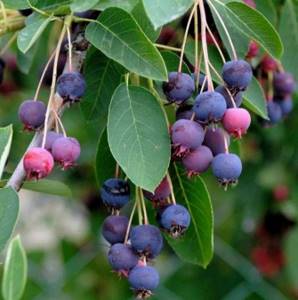
. However, when growing this variety, you must always keep the humidity level under control.
Flowering period
All species forms of serviceberry are distinguished by their neat appearance. Irga is a flowering plant that is attractive to insects. During the flowering period, it is covered with many buds. Depending on the variety, the color of the flowers can be not only pure white, but also pinkish. The buds are not arranged singly: they are arranged in delicate inflorescences.
Corinna blooms in spring. The excellent compatibility of serviceberry with other plants makes it possible to plant it in rows mixed with other shrub plants characterized by a summer flowering period. In this case, you can get a garden that will delight you with the beauty of colorful inflorescences, both in spring and summer. After the serviceberry has completely faded and sheds the petals of its fragrant inflorescences, the fluff from the leaves also disappears. And then it turns into an ordinary shrub with a well-developed stem part and a lush crown.
Fruit
During the fruiting period, small berries with pink barrels can be seen on the currant. They are collected on one brush. The unripe fruits of most varieties of serviceberry are cream-colored, and as they ripen they acquire a violet or purple color. The berries have a pleasant taste. Their delicate sweetness and juiciness attract both young children and adults. Birds and irgis love to feast on the fruits, after which they spread the seeds of the plant throughout the area. Berries from the bush should be collected only when ripe, otherwise they will not have healing properties.

The fruit contains a huge amount of useful substances - dietary fiber (up to 25 percent), glucose and fructose, vitamins C, P, and group B, pectin and phytosterols, carotene, fiber, as well as various microelements.
Properties of Canadian serviceberry berries - benefits or harm
Irga is worth the effort spent on its cultivation and further care. In addition to being spectacularly decorative, it has a lot of healing properties.
The berries contain pectin and carotene. Tannins, vitamin C, and a rare natural antioxidant - vitamin P. The beneficial properties of serviceberry are not limited to the presence of traditional vitamins.
Irga lowers blood pressure, promotes digestion, and normalizes sleep.
Eating fresh serviceberry berries will help lower blood cholesterol levels. Jam is great for sore throats and colds.
There are also disadvantages to berries. Drivers need to take the sedative effect into account - you shouldn’t get behind the wheel after eating too much shadberry at your favorite dacha. People suffering from diabetes and hemophilia should not abuse this berry. Ripe berries are very sweet, in addition, serviceberry thins the blood.
Saskatoon plant: medicinal properties
Few people know that all parts of this wonderful shrub are useful: flowers, berries, leafy parts, and bark. The shadberry plant contains a huge amount of vitamins, folic acid. It is used in folk medicine for vitamin deficiency, to strengthen the immune system, as well as to prevent heart attack, stroke and atherosclerosis. It is believed that the shadberry plant also helps fight the development of cancer, strengthens the walls of blood vessels, improves vision, and prevents cataracts. It perfectly helps heal purulent wounds. To do this, you need to apply bandages soaked in berry juice to them.
A tincture of irgi inflorescences will help normalize blood pressure and sleep. It is difficult to list all the ailments for which this miraculous shrub helps.
Requirements for location and soil
Irga is a long-liver. The shrub grows in the wild for about seventy years. Moreover, over time, its trunk becomes like a tree. On the site, you can choose any place for planting irgi: after all, the plant is unpretentious and can develop normally even in the shade, and besides, it is not afraid of drought and drafts.
But if there is a sunny place in the garden, then it will be ideal: in this case, the branches will not have to stretch upward in search of sunlight.
Irga is also not picky about soil. The main condition is that the place is not swampy. You need to know: the more fertile the soil, the healthier the plant will grow on the site and the richer the harvest will be.
Irga rotundifolia flowering
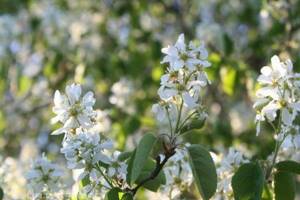
As a result, we can conclude that serviceberry is a very good plant for your garden. In addition to beautifully decorating a garden or cottage, serviceberry also has beneficial properties, as well as tasty fruits. Buy this bush and you won't regret it. It is not whimsical, requires little care, and it is easy to choose a place for planting, since it does not require special lighting and is not picky about the soil. It rarely gets sick, most often it avoids this irgu so that you don’t have to spend money on chemicals for spider mites and other diseases.
Landing
The place for shadberry must be prepared in advance, first of all by clearing it of all weeds. Before planting, you need to dig it up and add phosphorus and potassium fertilizers at the rate of 40 grams of each type per 1 square meter. m.
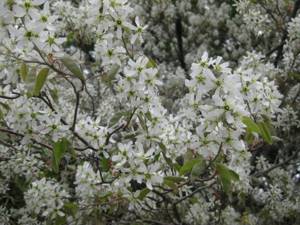
Seedlings must be one or two years old. If you plan to plant several bushes on a site at once, then experts recommend planting them in a checkerboard pattern one and a half meters apart from each other. The layer of earth that was dug out of the hole must be mixed with compost and sand in proportions 3:1:1. At the bottom of the hole you need to add a little fertilizer - potassium and phosphate, as well as humus. Seedlings should be sprinkled with a pre-prepared mixture and watered generously around the trunk. When the moisture is absorbed into the soil, you need to add a little more soil, level the hole, and mulch the soil. After this, the bush needs to be lightly trimmed, leaving no more than four buds in each shoot.
Irga care
In the first 3 years, the plant needs timely loosening of the soil, weeding and fertilization at the same rates as for currants (40–50 g of superphosphate, 10–15 g of potassium sulfate and 4–6 kg of organic fertilizers per bush). With the beginning of fruiting, in the 4th year, it may be necessary to tie the bushes with various materials to prevent the shoots from bending too much under the weight of the harvest. With age, the trunks become stable and the need for garter disappears.
It is best to form shadberry in the form of a multi-stemmed bush from strong basal shoots. Weak shoots are completely cut out.
Irga takes a lot of nutrients from the soil into the berries, so every year you should add compost or humus mixed with mineral fertilizers with loosening and digging at the rate of 0.5–1 bucket of compost mixed with 2–4 tablespoons of nitrophoska (or 2 tbsp. l superphosphate and potassium sulfate) and 1 glass of ash per 1 sq.m. In summer, liquid fertilizers made from ammonium nitrate (50 g per bush) or a 10% solution of bird droppings are useful for bushes. Fertilizing is carried out at night after rain or after heavy watering. During the period of pouring berries, shadberry is very responsive to watering. In dry weather, regular watering is required, otherwise you can completely lose the crop.
A sign of full ripening of the fruit is the slight release of juice when pressing on them with your fingers. The berries are tender and juicy, so they are collected in baskets. For processing, the berries are picked ripe, but under normal conditions they can be stored for no more than 2–3 days. This period can be significantly extended if they are stored at a temperature of about zero degrees.
Care Tips
Irga is considered an unpretentious crop. Many gardeners say that after planting they don’t remember about it until the very season when it’s time to harvest. Although it would be nice if this shrub still receives minimal attention. It consists of regular watering.
In some cases, the plant requires pruning so that this beautiful shrub does not lose its visual appeal. And rejuvenation will only benefit the plant, for example, in terms of yield. It is better to weed from time to time. Serviceberry has a very developed root system, so it is recommended to water it only during drought.
Fertilizer and feeding
The first fertilizer after planting should be given to the shadberry after it reaches five years of age. Once a year, you should dig up the tree trunk with the addition of 300 g of superphosphate and one bucket of humus.
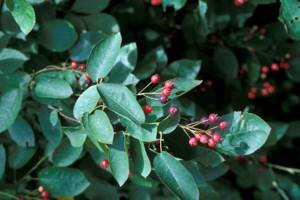
In addition, from early spring to mid-July, you can also feed the plant with liquid organic matter. A solution of chicken manure diluted in water in a ratio of 1:10 is suitable for this. For each bush you need to prepare about 5 liters of the mixture.
Pruning irgi, growing and caring for an adult plant
Recommendations for growing serviceberry do not differ from the traditional rules for growing fruit bushes, but there is less hassle.
- No chemical pest control required.
- There is no need to cover the bushes; the plant easily tolerates frost.
- In the future, you will only need to carry out traditional pruning for shrubs and apply fertilizers.
- A mature shadberry plant should be fed at the beginning of summer with a 10% solution of chicken manure - up to 5 liters. under a bush
The optimal height for an adult plant is up to 2.5 meters, which makes harvesting more convenient.
Spring pruning of irgi must be carried out from the age of 4 years. We thin out the bush, remove weak and dried branches; shorten shoots that are too tall. We treat each cut point with garden varnish. To form a healthy bush, it is enough to leave 15 strong skeletal branches. Watering - when you remember, drought is not a problem.
As for the downsides, irga will require attention and care of the root shoots. It will have to be removed regularly so that the bush maintains its beautiful shape.

Reproduction
Corinka can be grown from seeds. But in this case, you need to be prepared for the fact that with this type of propagation all varietal characteristics will disappear. Seeds extracted from ripe berries should be immediately planted in the ground to a depth of two centimeters. They need to be well watered and mulched on top. In winter, the seeds undergo natural stratification and in the spring young shoots appear from them. In some cases, the seeds germinate in the same autumn.
Another method is propagation by green cuttings. From an adult bush, cut cuttings about 15 cm long, remove all leaves from them, leaving only the top two. The lower cut must be placed in a special solution to form roots. After this, the cuttings should be washed with cold water and placed in a greenhouse at an angle, sprinkled with a layer of sand on top. The distance from the dome of the greenhouse to the top of the planting material should be about 20 cm. The cuttings should be watered so that the water does not stream onto the root part, but only splashes. In a maximum of three weeks, they will already take root normally, so you can open the greenhouse during the day.
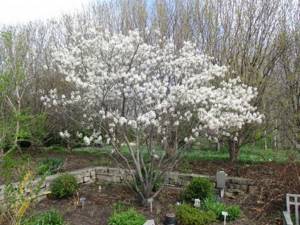
There is another way - propagation by layering. To do this, you need to select strong young shoots, dig them in in early spring, after pinching the tops. When young shoots emerge from the buds, they need to be covered with earth. There are three ways to propagate irgi, but experts say the simplest is division by green cuttings.
Berry propagation
Berry plants are grown in different ways. The most productive are vegetative techniques. They allow shadberry to be propagated while maintaining varietal characteristics, which is impossible with seed propagation.
Green cuttings
Cuttings do not require your own serviceberry tree or bush. Planting material is cut in June from the apical shoots of mature plants - 5-6 years old. The length of the cuttings is 10-15 cm. The lower leaf plates are torn off from them, saving only a couple of the upper ones. Place the workpieces for 12 hours in the root former with oblique cuts, which should be from the bottom. After time, rinse with running water. Planting is carried out at an angle in the ground, covered on top with a thick layer of sand - 10 cm. A distance of 3-4 cm is maintained between the cuttings. A mini-greenhouse is organized above them so that the dome rises in sections of 15-20 cm.
After planting, future serviceberry seedlings are watered through a fine sieve so that the water splashes and does not flow. Cover the cuttings with a dome to maintain a stable temperature at 22-23 ºC. To prevent the mercury column from rising above 25 °C, the plantings are regularly ventilated. If necessary, moisten the soil. After two to three weeks, the cuttings take root, then the protection can be removed completely.
Three-week-old serviceberry seedlings develop a strong fibrous root system, but they require growing:
- They are planted in the garden.
- When they take root, they are fed with slurry diluted with water 6-8 times, or with a mineral complex - 30 g of ammonium nitrate diluted in a bucket of water.
- The shadberry cuttings are cared for as if they were an adult plant, and next fall they are transplanted to a permanent location.
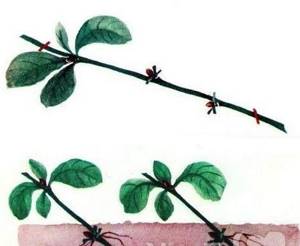
You can grow serviceberry seedlings yourself from green cuttings, which are recommended to be cut in early summer
By layering
You can also grow a young plant from cuttings. For the technique to be successful, developed one- or two-year-old shoots with powerful growths are chosen. The timing of the procedure is early spring, immediately after the earth warms up. In the fall, they prepare the area under the bush from which the cuttings will be taken. It is dug up, fertilized and leveled.
When the time comes, grooves are made on it, shoots are placed there and secured in the furrow, and the tops are pinched. When young shoots 10-12 cm high develop from the buds of the cuttings, they are sprinkled halfway with fertile soil or humus. After 2-3 weeks, as soon as the shoots grow by the same amount, they are again sprinkled with half of them.
Attention! Rooted layerings of serviceberry are separated from the bush in the fall or next spring and transferred to a permanent place.
Dividing the bush
Since it is not easy to transplant an adult shadberry, they resort to this method of propagation if it is necessary to move the plant to a new area. The best time is early spring (before sap flow begins) or autumn (a month before frost). Corinna reproduces like this:
- The plant is dug up and pruned, removing old shoots.
- Free the roots from the ground.
- Divide the rhizome into several parts. Sometimes you have to use an axe. Each division of serviceberry should have a healthy ground part, consisting of at least two shoots, and a well-developed root system.
- Old roots are cut off, the rest are trimmed, after which parts of the bush are planted in prepared holes.
Irga is an excellent choice for summer residents who are often absent from the site. Thanks to its undemanding nature, caring for and growing the crop as a whole is very simple and not labor-intensive.
Diseases and pests of serviceberry
Corinka has a fairly good immune system, but from time to time it still suffers from tuberculosis: the plant’s leaves first turn brown, then dry out and fall off. Following them, the branches are affected, on which small red tubercles begin to appear. After detecting these symptoms, you must immediately cut off and burn the diseased parts, and spray the bush itself with copper sulfate or Bordeaux mixture. Some gardeners carry out this procedure in the spring for preventive purposes.
In addition to tubercularosis, phyllostictosis spotting can sometimes be found on serviceberry, manifested by wilting of leaves on which brown spots have appeared. Treatment of the bush is the same - using vitriol and removing the affected parts.
Another disease - gray rot - is manifested by the appearance of spots on the leaves that spread. The green part of the bush begins to turn yellow, then it becomes covered with fluffy gray mold. As a result, the leaves fall off. The cause of this disease is excess moisture. Therefore, the first thing you need to do is eliminate it, and if possible, transplant the shadberry to a drier place.
As for the pests that attack shrubs, the most important enemies of currants are the shrubby seed-eaters. Already from the name you can immediately guess that this parasite, penetrating inside the fruit, begins to eat the seeds. There, in the berries, it pupates. Sometimes the moth is also found on the serviceberry, which damages the foliage of the bush. As a result, it dries out. These pests need to be controlled with the help of either karbofos or fufanon.
A few recommendations
Black currants, raspberries, and gooseberries grow quite calmly next to the shadberry plant. Neighborhood with other plants, for example, birch or Manchurian walnut, is not recommended. They inhibit shadberry and consume a lot of moisture.
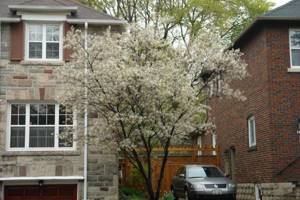
Irga will not bring unnecessary trouble, will not take up a lot of time, but it will decorate your garden plot and delight you with a harvest of delicious and incredibly healthy fruits.
In addition, it is winter-hardy, so even Michurin at one time recommended this crop as a rootstock for apple and pear trees in the north.
How to plant shadberry: timing, place and planting rules
Irga is a powerful, tall crop; its berries ripen at the same time as currants. Irga contains a lot of pectin (up to 7%), and this is a good natural sponge that removes waste and toxins from the body. Irga is an absolutely capricious berry crop. It is unpretentious in care, winter-hardy and undemanding in terms of timing and place of planting. Will take root in any cultivated area. For the plant to feel good, it is enough to follow basic agrotechnical practices.

I became interested in Irga more than 15 years ago. I was introduced to her by the outstanding and now departed professor E.P. Kuminov, a famous breeder of berry crops, Doctor of Agricultural Sciences. I defended my PhD thesis on Irga and, thanks to the seedlings carefully sown by Evgeniy Petrovich, I developed the Starry Night , which has been included in the State Register since 2016.
Planting dates for irgi
Irga is amazingly winter-hardy. Even Michurin recommended irgu as a rootstock for growing apple and pear trees in the far north.
You can literally plant shadberry in frozen soil in autumn and winter. At the same time, there is absolutely no fear that she will die. The main thing is that the root system of the seedling is well developed.
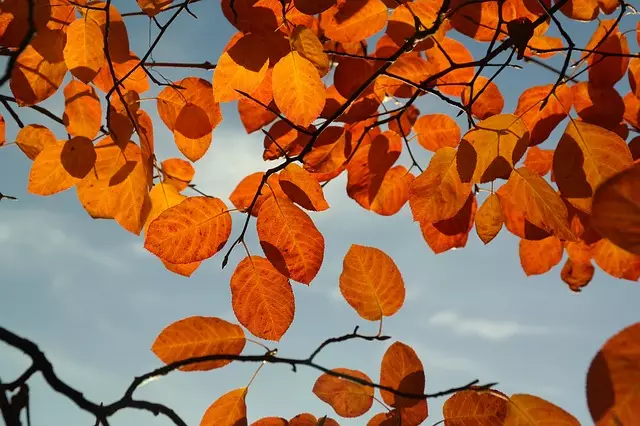
Igi planting site
On the one hand, the serviceberry is undemanding, so the landing site can be anywhere. On the other hand, you need to understand that a living plant will not grow in a swamp; in harsh shade it will always reach for the light, and in poor, dense soil it will not produce a good harvest.
The best place to plant irgi:
- soils with a neutral environmental reaction, loose, moderately moist and moderately fertile.
- in winter, so that more snow accumulates, and melt, rain, and irrigation water does not stagnate for a long time,
- the place should be protected from the north from the cold wind,
- The groundwater level is located at least 2 m below the soil surface.
What to plant next to irga?
Quite calmly next to the shadberry, retreating 2.5-3 m, you can plant:
- black currant,
- raspberries,
- gooseberry.
It is better not to plant next to irga:
- Manchurian nut (depresses shadberry),
- birch (absorbs a lot of moisture from the soil).

Hole for planting irgi
The planting hole is prepared in advance, preferably a couple of weeks before planting the shadberry. I advise you to dig a hole 25-30% larger in width and depth than the volume of the root system of the seedling.
At the bottom of the planting hole, be sure to lay a 2-3 cm layer of drainage (gravel, expanded clay, broken brick, small stones). On top of the drainage, place a layer of nutritious soil mixture of turf soil, humus, topsoil (2 kg each) with the addition of 1 tbsp. l. nitroammophoska (complex mineral fertilizer). Mix everything thoroughly and place it in the base of the hole, pour in 1 bucket of water.
Rules for planting serviceberry
We place the seedling in a previously prepared planting hole and sprinkle it with soil:
- We install the root system of the serviceberry seedling on the moistened nutrient soil mixture, carefully straightening the roots;
- sprinkle the roots with soil, shaking the seedling a little so that no voids form between the roots and the soil;
- compact the soil and water with a couple of buckets of water;
- mulch the surface with a 2 cm layer of humus.
Should I deepen the root collar when planting serviceberry?
When planting, pay attention to the root collar - the place where the roots transition into the stem:
- If you want the seedling to form into a tree, place the root collar 2 cm above the soil surface.
- If you need a bush with replacement shoots that actively grow from the roots, then deepen the root collar by 2 cm.
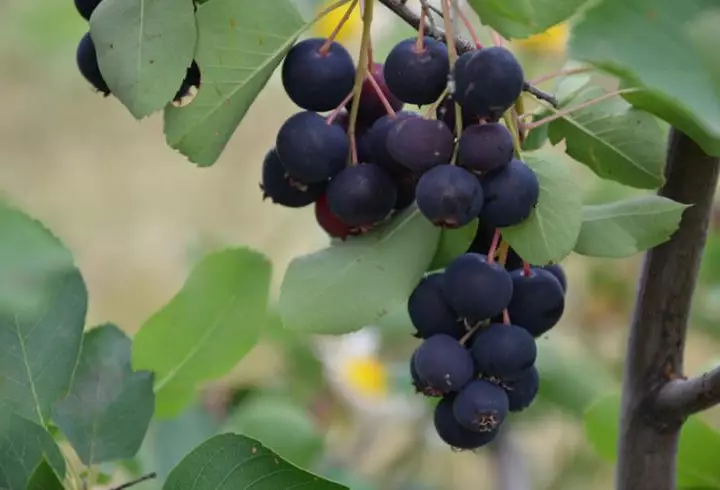
Planting scheme for irgi
The planting scheme for irgi depends on whether it is a species or a variety. As a rule, varieties are characterized by restrained growth, so if you plant 2 serviceberry plants of different varieties, you can leave 3 m of free space between them. The same amount can be retreated from fences, house walls, other plants and buildings.
Features of planting species of serviceberry
If we are talking about types of serviceberry, then the planting scheme and timing for them will be slightly different. In total, 2 types of serviceberry are usually grown in culture:
- irga alnifolia,
- Serviceberry Canadian, or close to it in appearance, taste and size of the fruit of Serviceberry Lamarck.
Irga alnifolia has a less spreading crown, so 3 m between plants is quite enough. Due to their increased winter hardiness, shadberry and its cultivars ( Starry Night , Mandan ) can be planted in the fall (before the soil freezes) and spring (after it thaws).
Irga Lamarca or Canadian serviceberry differs only in minor changes in the structure of the flower and is characterized by a highly spreading crown. They need to be planted less frequently, spaced 4 m apart. Canadian shadberry , Lamarck shadberry and their varieties ( Slate ) either in early autumn or spring. They are less winter-hardy than shadberry.
Read more about the types and varieties of serviceberry.
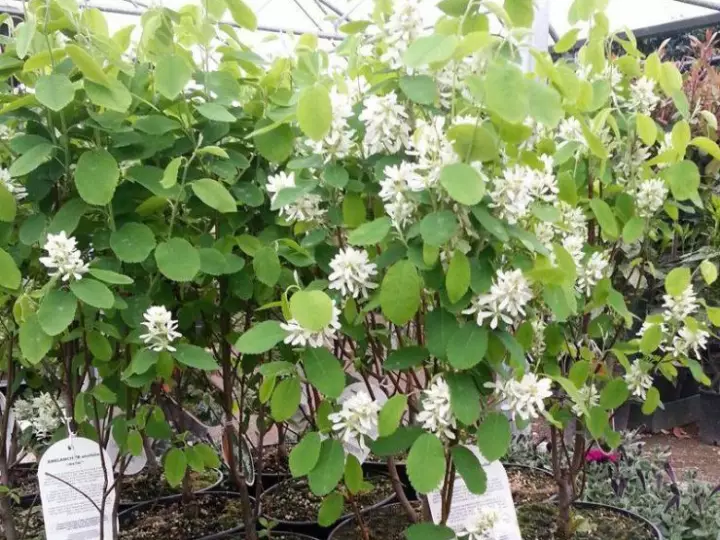
Caring for irga after planting
Caring for irga after planting comes down to removing weeds in the bush area, loosening the soil, and fertilizing. Water the irgu during drought.
To feed the serviceberry, complex mineral fertilizer is applied in the spring (1 tbsp each of nitroammophosphate), in the summer - phosphorus and potassium fertilizers (1 tsp each of potassium sulfate and superphosphate), and in the fall you can get by with potassium fertilizers (250-300 g of wood ash each). ).
Read more about caring for irga.
Trimming serviceberry after planting
- If the root system of the serviceberry seedling is not damaged, then pruning is not necessary.
- If the roots are damaged, then it is advisable to at least approximately subordinate the above-ground and underground parts, cutting off the shoots by 1/3 of their length immediately after planting or in the spring.
Sanitary pruning of serviceberry involves removing dry and broken shoots, those that grow deep into the crown, leading to thickening. Shrub pruning can be done at any time of the year, even in summer. Therefore, shadberry is often used in the design of an orchard, as a deciduous hedge.
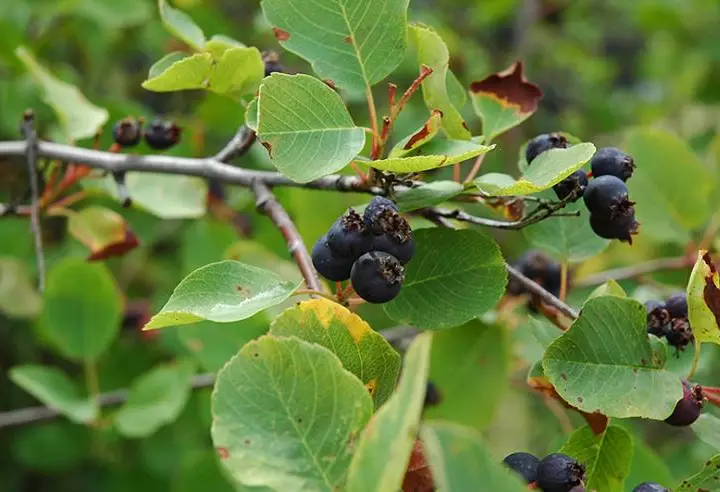
In what year after planting does the shadberry bear fruit?
The timing when serviceberry plants begin to bear fruit depends greatly on the seedlings:
- If these are seedlings, then you will have to wait 3-4 years for fruits, provided they are well cared for.
- If these are grafted plants (for shadberry, mountain ash, hawthorn), then fruits can be produced already in the year of grafting (spring copulation) or the next year (summer budding).
Nikolay Khromov, Candidate of Agricultural Sciences, senior researcher

